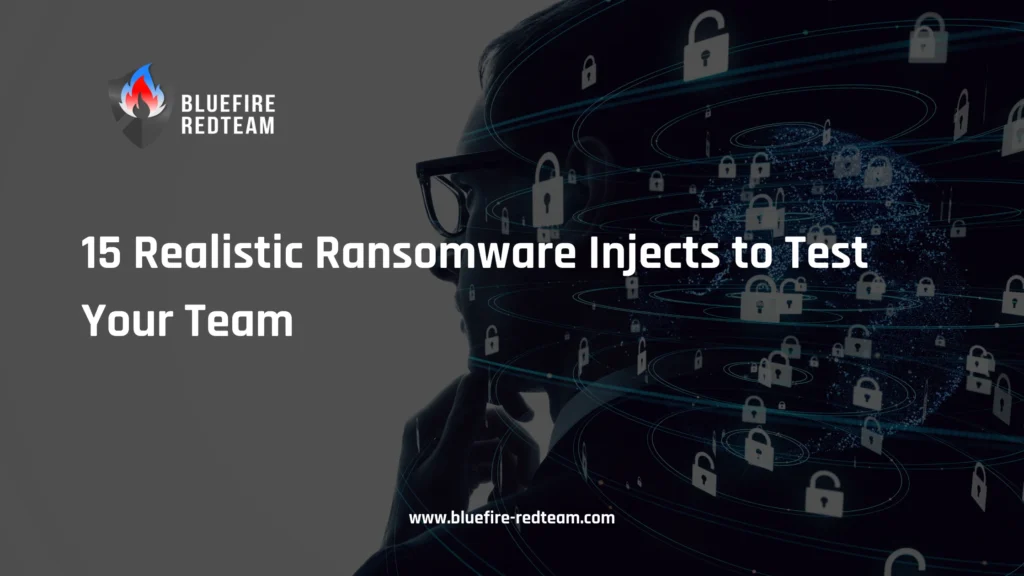Employ these 15 realistic ransomware injects as a pre-prepared library for tabletop drills and war-rooms. Each scenario comprises: the goal, the things to introduce / read out, the anticipated participant actions, the level of difficulty, and the way to evaluate success. These are designed to reveal the decision-making gaps among IT, Security, Legal, Comms, and Executive teams—and to lead the intrigued teams to practical remediation with Bluefire Redteam’s Defense Checker.
⚡ Tip: mix low-, medium- and high-difficulty injects across phases (discovery → escalation → containment → recovery).
👉 When you want a quick baseline, have participants run Bluefire Redteam’s Defense Checker before the exercise so you can compare real performance to your baseline.
How to use this inject library
- Pick 4–8 injects for a 2–3 hour tabletop; use 8–15 for a half-day to full-day exercise.
- Sequence injects to escalate pressure and force trade-offs (e.g., technical containment vs. public comms).
- Record decisions, timelines, and who is contacted. Use these artifacts in the hotwash.
- After the exercise, map inject outcomes to prioritized remediation actions and track with the Defense Checker baseline.
Inject 1 — Initial Detection: Strange Process + Encryption Alert

Purpose: Test early detection & escalation.
Readout: “SOC alerts: encrypted files detected on file-share server FS-Prod-01; process svchost32.exe created multiple handles.”
Expected actions: Triage by SOC, initial containment (isolate host), notify Incident Lead, kick off IR playbook.
Difficulty: Low
Measure: Time to detection acknowledgment; time to declare incident; evidence collected.
Inject 2 — Ransom Note Delivery to Finance

Purpose: Test legal, finance, and exec escalation.
Readout: “Finance receives an email with ransom demand and proof file with client data.”
Expected actions: Legal and Compliance consulted; decision whether to pay; evidence preservation; external counsel engaged.
Difficulty: Medium
Measure: Decision chain clarity; legal notification time; preservation of ESI.
Inject 3 — Backups Appear Compromised
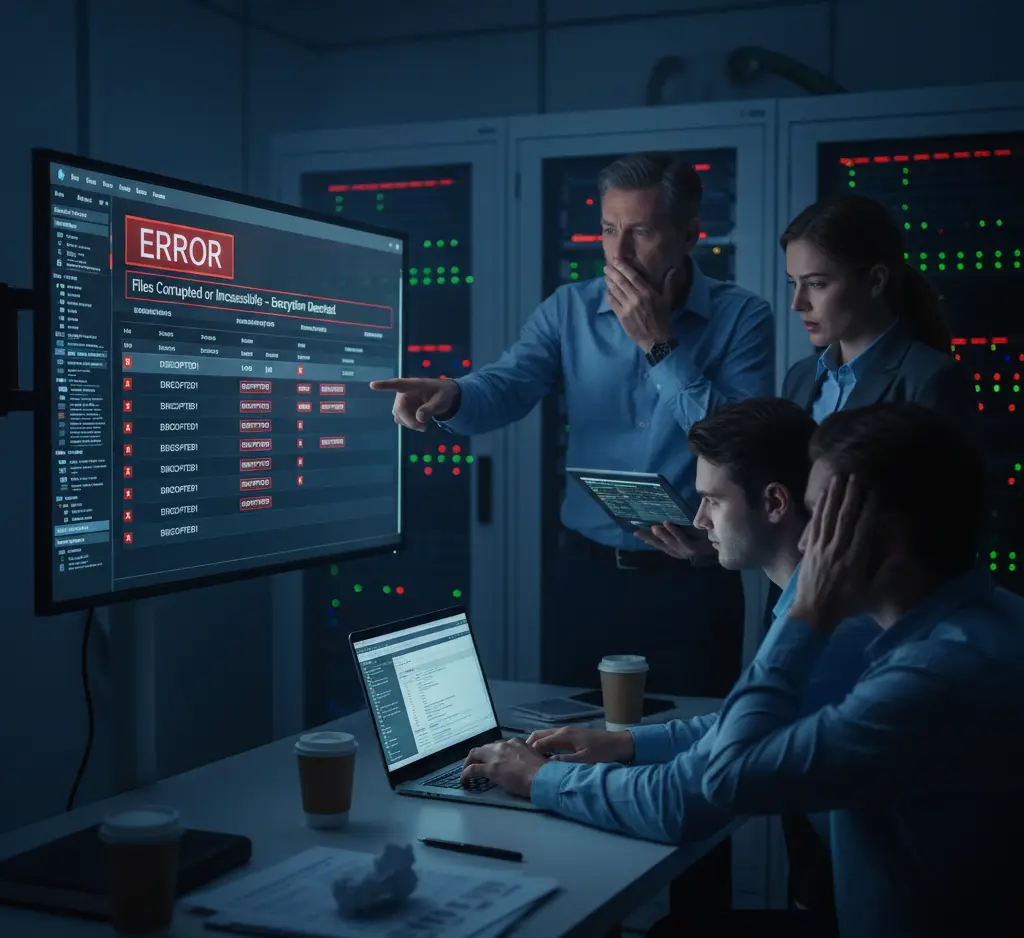
Purpose: Test recovery assumptions and backup validation.
Readout: “Backup restores are failing; backup logs show unexpected deletions around 02:00 UTC.”
Expected actions: Verify backup integrity, declare possible destruction of backups, begin alternate recovery plan.
Difficulty: High
Measure: Recovery plan activation time; fallback plan readiness; RTO estimate accuracy.
Inject 4 — Active Lateral Movement Observed

Purpose: Test containment and segmentation.
Readout: “Alerts show lateral movement from workstation to domain controller via SMB.”
Expected actions: Network segmentation, contain affected segments, revoke privileged sessions, AD forensics.
Difficulty: High
Measure: Time to network segmentation; privileged account usage audit; scope containment.
Inject 5 — Public Leak Threat (Leaks to Dark Web)

Purpose: Test comms and legal response to extortion + data leak threats.
Readout: “Threat actor claims exfiltration and threatens public leak in 48 hours.”
Expected actions: Legal and PR coordinate statement plan, assess regulatory notification needs, consider law enforcement.
Difficulty: Medium
Measure: Draft statement time; notification decision time; regulator notification plan.
Inject 6 — Insider Access Compromised (Phishing + Privilege Abuse)

Purpose: Test identity, HR, and access controls.
Readout: “An admin credential appears to be used from an unusual IP; suspicious password reset activity noted.”
Expected actions: Revoke suspect credentials, require password resets, map recent access, interview HR about insider risk.
Difficulty: Medium
Measure: Time to revoke credentials; completeness of access audit; HR communication clarity.
Inject 7 — Third-Party Vendor Notified of Compromise

Purpose: Test supply chain communication and vendor contracts.
Readout: “Vendor X warns that a shared integration may have been used to pivot.”
Expected actions: Validate vendor claim, isolate integration, review SLAs and contractual obligations, notify customers as needed.
Difficulty: Medium
Measure: Vendor validation time; containment of integration; contract escalation clarity.
Inject 8 — Customer Data Exposure Confirmed
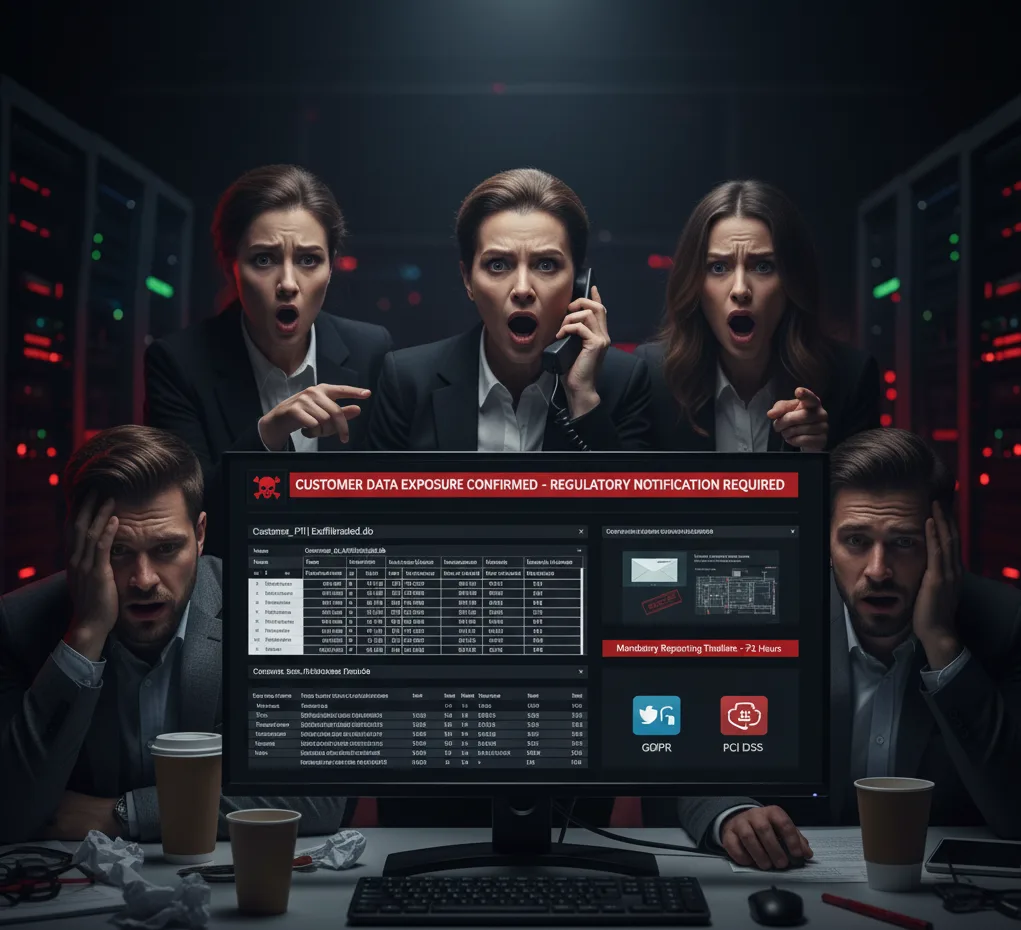
Purpose: Test breach notification processes and regulatory posture.
Readout: “Forensic reveals unencrypted PII exfiltrated for 10,000 customers.”
Expected actions: Legal and compliance determine notification obligations; prepare letters; engage data protection officer.
Difficulty: High
Measure: Time to notification decision; quality of notification templates; escalation to leadership.
Inject 9 — Media Inquiry / Journalist Calls

Purpose: Test external communications and reputational control.
Readout: “Journalist: ‘We heard about a possible outage and exfiltrated data. Can you comment?’”
Expected actions: PR prepares holding statement, legal clears content, exec decides spokesperson, media training use.
Difficulty: Low
Measure: Time to holding statement; adherence to messaging guidelines; designated spokesperson clarity.
Inject 10 — Ransom Negotiation Offer (Attacker Initiates Chat)
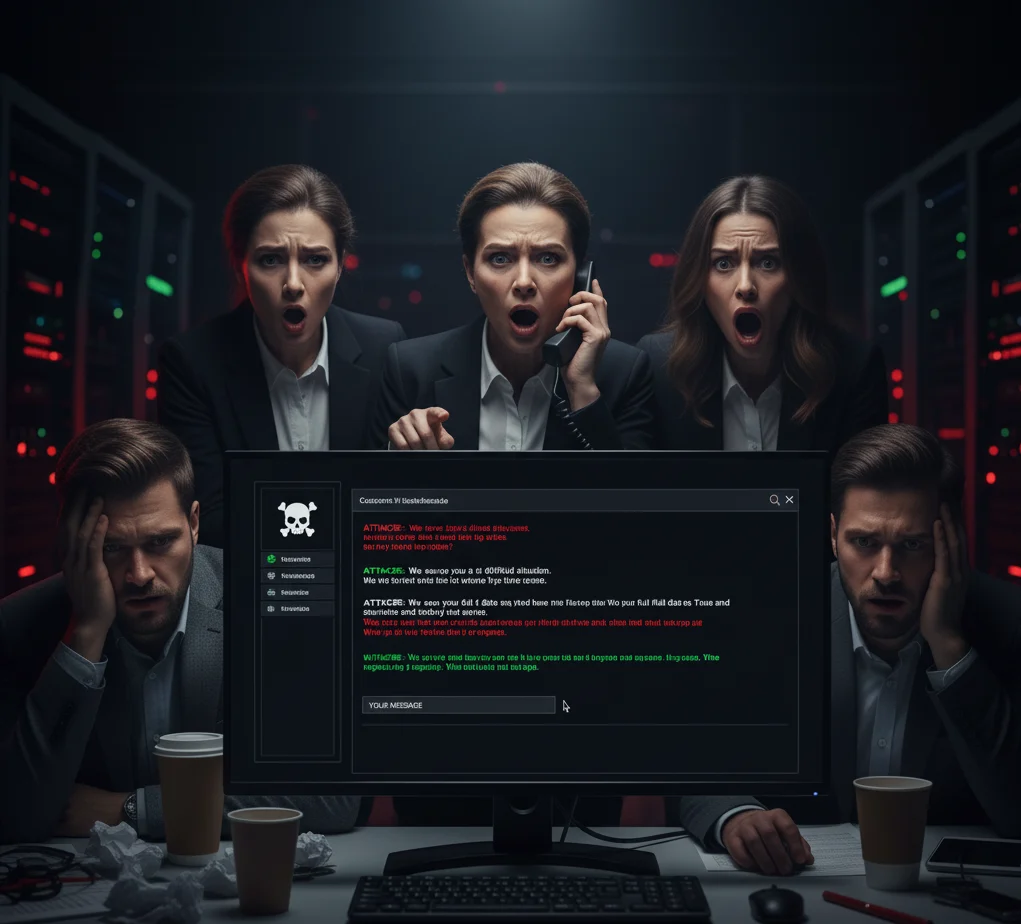
Purpose: Test negotiation protocol and law enforcement coordination.
Readout: “Attacker initiates contact offering a decryption key if paid; proposes conditions.”
Expected actions: Legal and exec decide negotiation posture, law enforcement consulted, preserve chat logs.
Difficulty: High
Measure: Adherence to policy for extortion handling; preservation of evidence; negotiation decision timeline.
Inject 11 — Business Continuity: Critical System Outage

Purpose: Test business continuity and service-level prioritization.
Readout: “Payment gateway and customer portal unavailable, impacting revenue-critical services.”
Expected actions: Activate BCP, route to manual processes, prioritize recovery tasks, exec decision on downtime communications.
Difficulty: High
Measure: BCP activation speed; gap between technical recovery and business operations continuity.
Inject 12 — Legal Holds vs. Data Deletion Requests
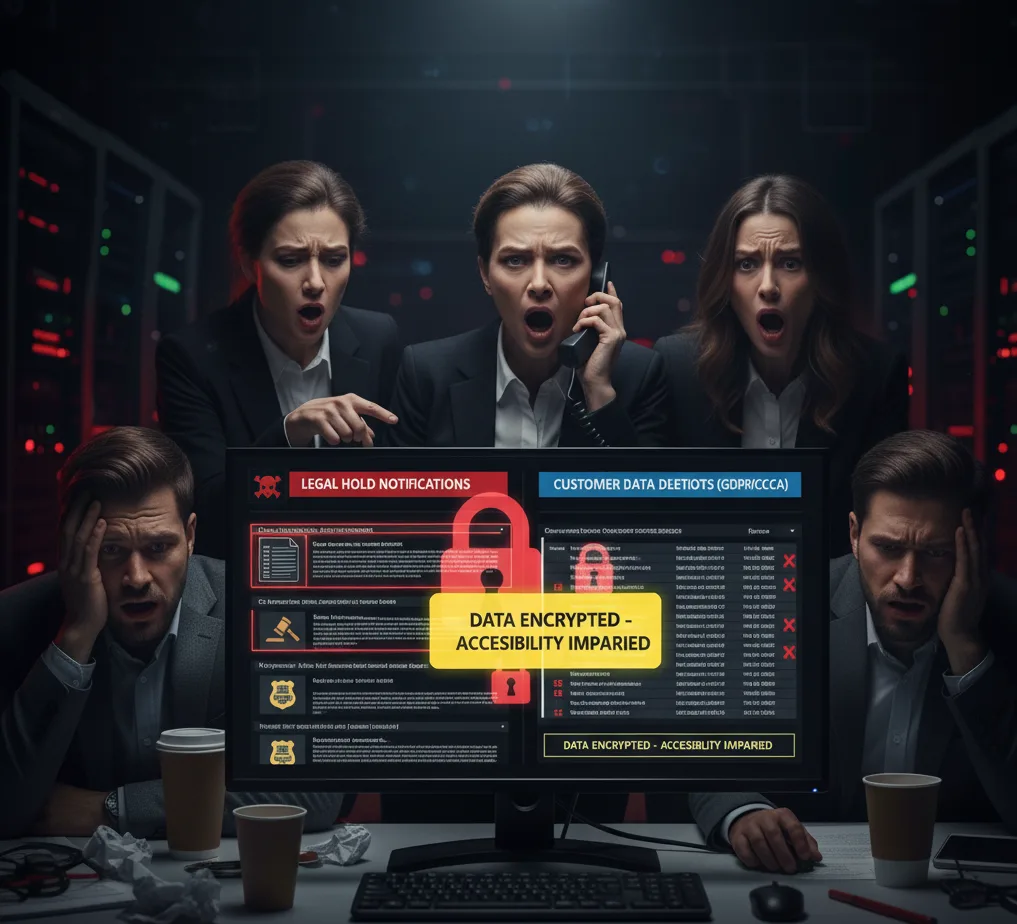
Purpose: Test conflicting legal/comms requests under pressure.
Readout: “A regulator asks for data deletion; litigation counsel requests legal hold on the same dataset.”
Expected actions: Legal reconciles conflicting obligations, documents rationale, informs stakeholders.
Difficulty: Medium
Measure: Legal decision clarity; documentation completeness; stakeholder notifications.
Inject 13 — False Positive / Red Herring (Decoy Alert)
Purpose: Test decision rigor and stress-induced mistakes.
Readout: “Alert indicates possible ransomware, later found to be benign. Team must validate.”
Expected actions: Validate alert, avoid knee-jerk declarations, determine evidence to confirm, refine alert tuning.
Difficulty: Low
Measure: False positive triage time; impact on operations; learning captured for tuning.
Inject 14 — Compliance Audit Mid-Incident
Purpose: Test regulatory readiness when under active response.
Readout: “An unexpected compliance audit begins and requests logs and incident documentation.”
Expected actions: Secure and provide evidence, designate a compliance liaison, ensure chain-of-custody.
Difficulty: Medium
Measure: Time to compile requested artifacts; chain-of-custody documentation quality.
Inject 15 — Post-Incident Ransomware Variant Emerges (Re-Encryption)
Purpose: Test long-tail resilience and lessons-learned implementation.
Readout: “After initial recovery, attackers release a new payload that re-encrypts restored systems.”
Expected actions: Reassess recovery assumptions, rebuild from clean sources, escalate to root-cause analysis, update playbooks.
Difficulty: High
Measure: Time to identify re-encryption; effectiveness of isolation and rebuild; updates made to IR playbook.
Exercise Scoring & Success Metrics
Use a simple scoring rubric per inject to quantify performance:
- Detection & Escalation (0–5): How fast and accurately was the incident detected and escalated?
- Decision Quality (0–5): Were decisions consistent with policy and risk appetite?
- Coordination (0–5): Did teams coordinate effectively across functions?
- Evidence & Documentation (0–5): Was evidence preserved and actions recorded?
- Recovery & Containment (0–5): Were containment and recovery steps appropriate and timely?
Total per inject = 0–25. Aggregate to get a simulated Exercise Performance Score.
After-Exercise: Hotwash & Prioritization
- Capture timelines and decisions for each inject.
- Map root causes to existing controls.
- Tag remediation actions by priority (Critical / High / Medium / Low).
- Assign owners and deadlines.
- Re-run relevant injects in 3 months to validate fixes.
Plug the Gap with Bluefire Redteam & Defense Checker
The purpose of these injects is to highlight the precise types of gaps that Bluefire Redteam discovers during actual engagements. Before running a tabletop, get an immediate baseline: have your team complete Bluefire Redteam’s Defense Checker. It gives a quick ransomware readiness snapshot you can compare against exercise performance — then Bluefire Redteam can help you close critical gaps with targeted tabletops, follow-on red teaming, and prioritized remediation playbooks.
👉 Run the Defense Checker to benchmark your current state and unlock tailored inject recommendations.
